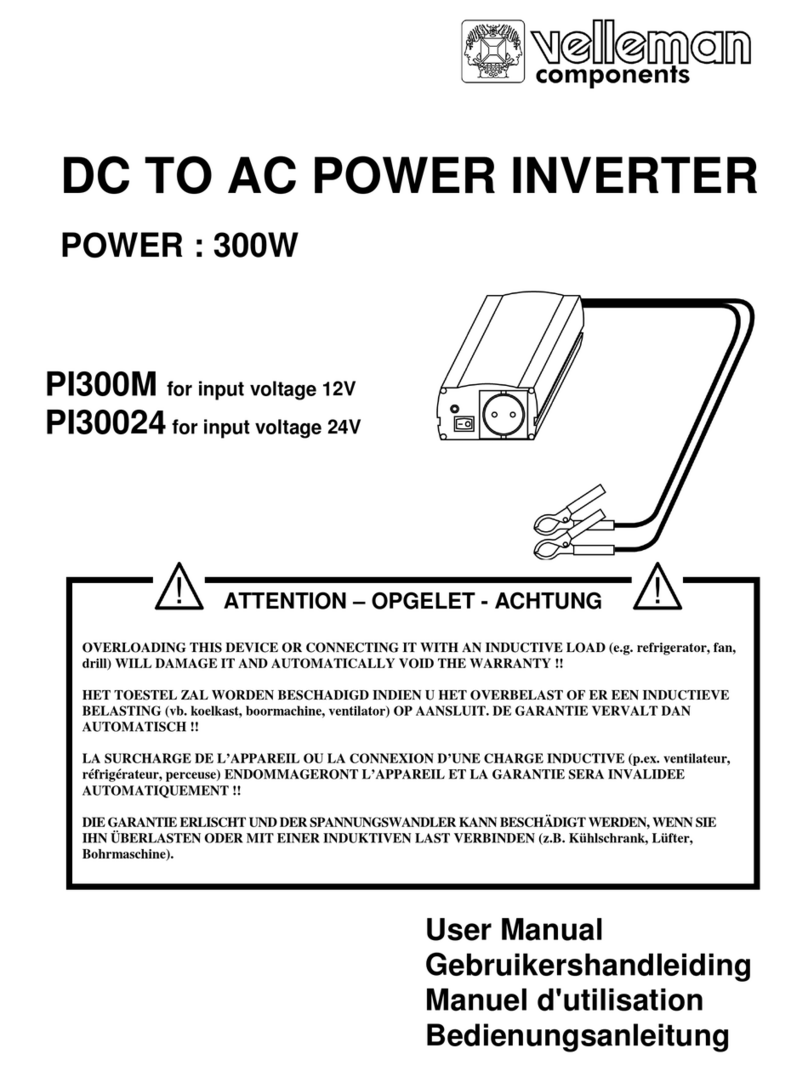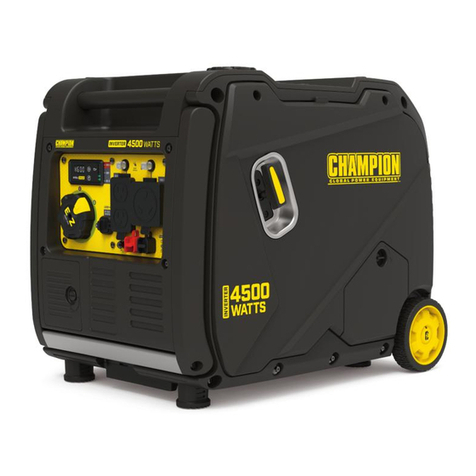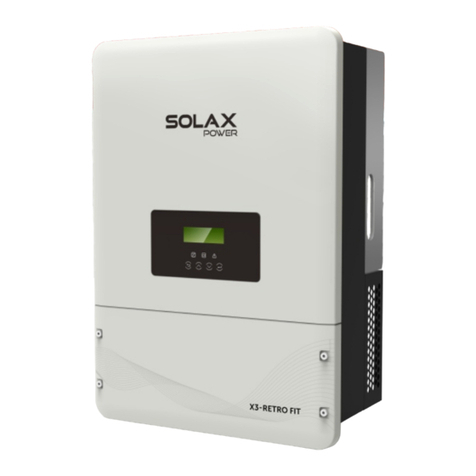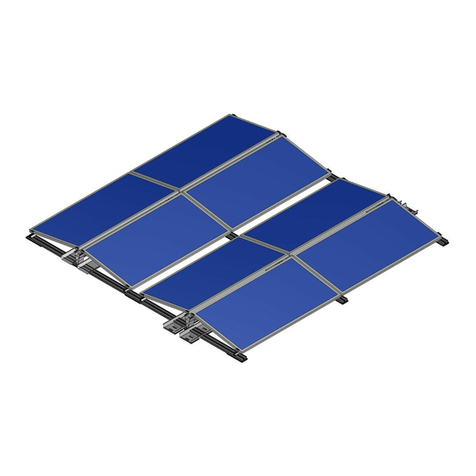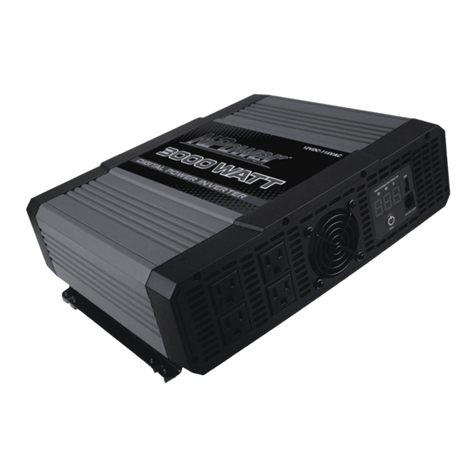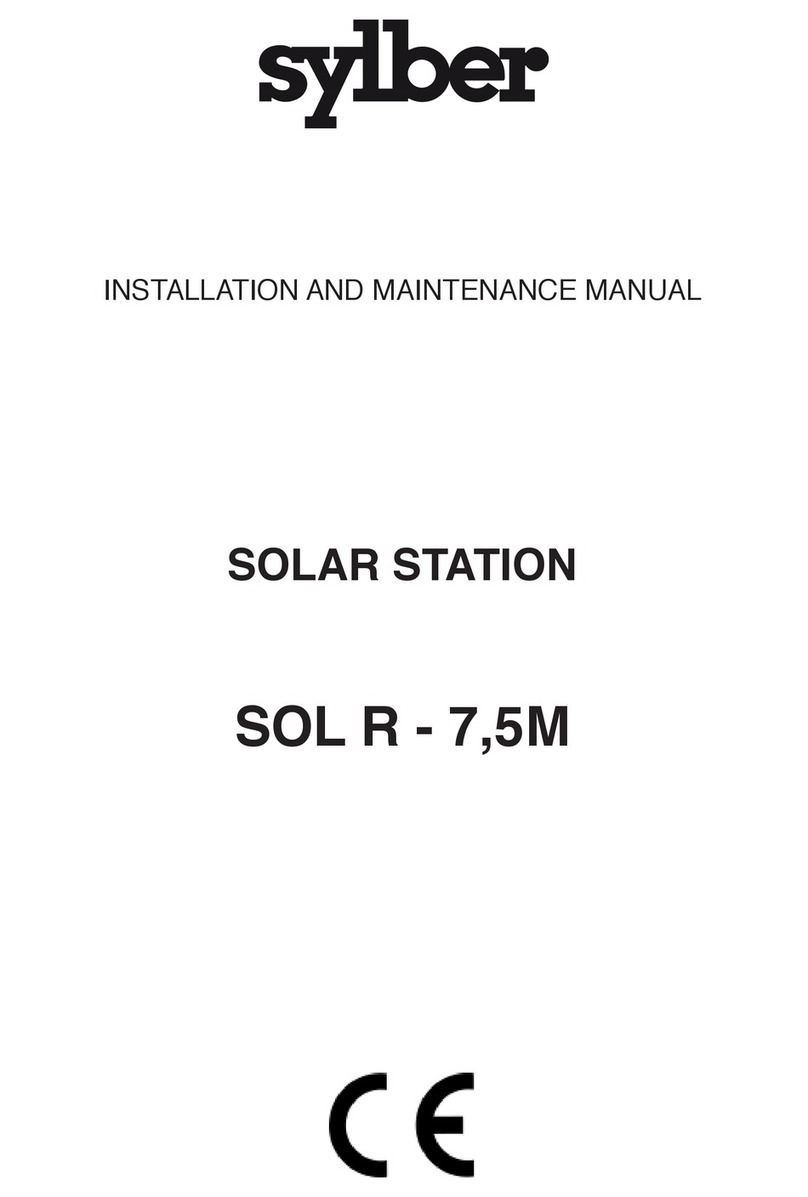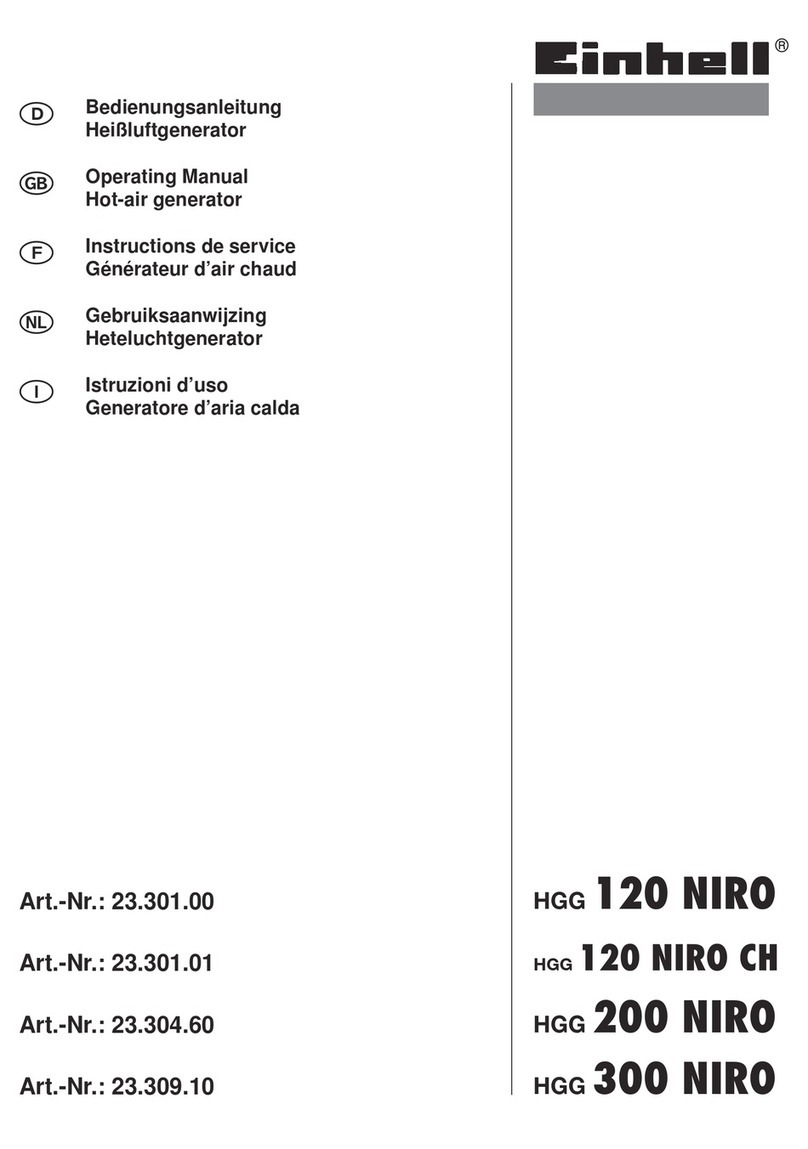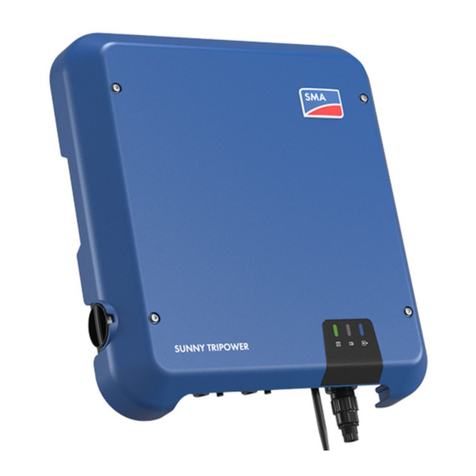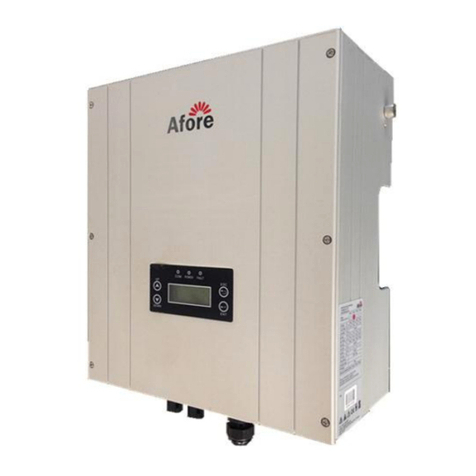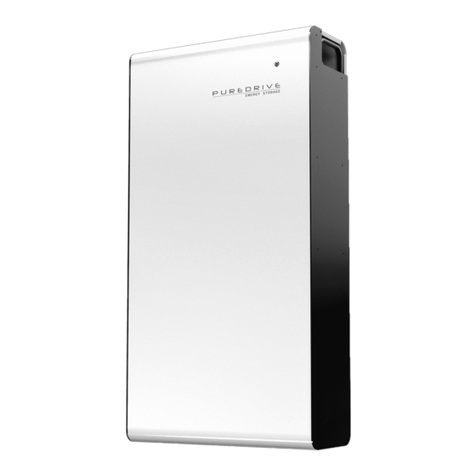PowMr POW-HVM5.5M User manual

1

1
Important Safety Instructions
Please save these instructions for future use!
Read all of the instructions and cautions in the manual before beginning the installation !
Purpose
This manual describes the assembly, installation, operation and troubleshooting of this unit. Please
read this manual carefully before installations and operations. Keep this manual for future
reference.
Scope
This manual provides safety and installation guidelines as well as information on tools and wiring.
Safety Instructions
WARNING: This chapter contains important safety and operating instructions. Read and
keep this manual for future reference.
⚫Before using the unit, read all instructions and cautionary markings on the unit, the batteries and
all appropriate sections of this manual.
⚫CAUTION --To reduce risk of injury, charge only deep-cycle lead acid type rechargeable
batteries. Other types of batteries may burst, causing personal injury and damage.
⚫Do not disassemble the unit. Take it to a qualified service center when service or repair is
required. Incorrect re-assembly may result in a risk of electric shock or fire.
⚫To reduce risk of electric shock, disconnect all wirings before attempting any maintenance or
cleaning. Turning off the unit will not reduce this risk.
⚫CAUTION –Only qualified personnel can install this device with battery.
⚫NEVER charge a frozen battery.
⚫For optimum operation of this inverter/charger, please follow required spec to select appropriate
cable size. It’s very important to correctly operate this inverter/charger.
⚫Be very cautious when working with metal tools on or around batteries. A potential risk exists to
drop a tool to spark or short circuit batteries or other electrical parts and could cause an
explosion.
⚫Please strictly follow installation procedure when you want to disconnect AC or DC terminals.
Please refer to INSTALLATION section of this manual for the details.
⚫Fuse is provided as over-current protection for the battery supply.
⚫GROUNDING INSTRUCTIONS -This inverter/charger should be connected to a permanent
grounded wiring system. Be sure to comply with local requirements and regulation to install this
inverter.
⚫NEVER cause AC output and DC input short circuited. Do NOT connect to the mains when DC
input short circuits.
⚫Warning!! Only qualified service persons are able to service this device. If errors still persist
after following troubleshooting table, please send this inverter/charger back to local dealer or
service center for maintenance.

2
Table of Contents
Important Safety Instructions....................................................................................................... 1
Purpose.................................................................................................................................. 1
Scope ..................................................................................................................................... 1
Safety Instructions .................................................................................................................. 1
Introduction................................................................................................................................... 4
Features ................................................................................................................................. 4
Basic System Architecture ...................................................................................................... 5
Product Overview ................................................................................................................... 6
Installation..................................................................................................................................... 7
Unpacking and Inspection....................................................................................................... 7
Select the mount location........................................................................................................ 7
Mount the inverter................................................................................................................... 8
Preparation............................................................................................................................. 8
Connection .................................................................................................................................... 9
Battery Connection ................................................................................................................. 9
AC Input/Output Connection ..................................................................................................11
PV Connection...................................................................................................................... 13
Final Assembly ..................................................................................................................... 15
Operation..................................................................................................................................... 16
Power ON/OFF..................................................................................................................... 16
Operation and Display Panel ................................................................................................ 16
LCD Display Icons ................................................................................................................ 17
LCD Setting .......................................................................................................................... 19
LCD display description ........................................................................................................ 32
Operating Mode Description ................................................................................................. 37
Fault Reference Code........................................................................................................... 43
Warning Indicator.................................................................................................................. 45
Battery Equalization.................................................................................................................... 47
Setting For Lithium Battery ........................................................................................................ 49
Lithium Battery Connection................................................................................................... 49
Setting for PYLON US2000 lithium battery............................................................................ 50
Table of Contents

3
Setting for lithium battery without communication.................................................................. 51
Specifications.............................................................................................................................. 53
Table 1 Line Mode Specifications.......................................................................................... 53
Table 2 Inverter Mode Specifications..................................................................................... 54
Table 3 Charge Mode Specifications..................................................................................... 55
Table 4 General Specifications.............................................................................................. 56
Trouble Shooting ........................................................................................................................ 57
Parallel Installation Guide .......................................................................................................... 59
Instruction............................................................................................................................. 59
Package Contents ................................................................................................................ 59
Mounting the Unit.................................................................................................................. 59
Wiring Connection ................................................................................................................ 60
Parallel Operation in Single phase ........................................................................................ 62
Support 3-phase equipment.................................................................................................. 65
PV Connection...................................................................................................................... 67
Commissioning ..................................................................................................................... 67
Trouble shooting ................................................................................................................... 69

4
Introduction
This is a multi-function inverter/charger, combining functions of inverter, MPPT solar charger and
battery charger to offer uninterruptible power support with portable size. Its comprehensive LCD
display offers user-configurable and easy-accessible button operation such as battery charging
current, AC/solar charger priority, and acceptable input voltage based on different applications.
Features
⚫Pure sine wave inverter
⚫Inverter running without battery
⚫Built-in MPPT solar controller
⚫Configurable input voltage range for home appliances and personal computers via LCD setting
⚫Configurable battery charging current based on applications via LCD setting
⚫Configurable AC/Solar Charger priority via LCD setting
⚫Compatible to mains voltage or generator power
⚫Auto restart while AC is recovering
⚫Overload/ Over temperature/ short circuit protection
⚫Smart battery charger design for optimized battery performance
⚫Cold start function
⚫Self-consumption and feed-in to the grid
⚫Statistics and records of power generation
Introduction

5
Basic System Architecture
The following illustration shows basic application for this inverter/charger. It also includes following
devices to have a complete running system:
1.Generator or Utility.
2.PV modules (option)
Consult with your system integrator for other possible system architectures depending on your
requirements.
This inverter can power all kinds of appliances in home or office environment, including motor-type
appliances such as tube light, fan, refrigerator and air conditioner.
Figure 1 Hybrid Power System

6
Product Overview
NOTE: For parallel model installation and operation, please check the parallel installation guide for
the details.
1. LCD display
2. Status indicator
3. Charging indicator
4. Fault indicator
5. Function buttons
6. Power on/off switch
7. AC input
8. AC output
9. PV input
10. Battery input
11. Circuit breaker
12. RS232 communication port
13. Parallel communication port
(only for parallel model)
14. AC grid current sensor
15. RS485 communication port
16. Grounding

7
Installation
Unpacking and Inspection
Before installation, please inspect the unit. Be sure that nothing inside the package is damaged.
You should have received the following items inside of package:
1.The unit x 1
2.User manual x 1
Select the mount location
Consider the following points before selecting where to install:
1. Do not mount the inverter on flammable
construction materials.
2. Mount on a solid surface.
3. Install this inverter at eye level in order to allow
the LCD display to be read at all times.
4. The ambient temperature should be between 0°C
and 55°C to ensure optimal operation.
5. The recommended installation position is to be
adhered to the wall vertically.
6. Be sure to keep other objects and surfaces as
shown in the right diagram to guarantee sufficient
heat dissipation and to have enough space for removing wires.
SUITABLE FOR MOUNTING ON CONCRETE OR OTHER NON-COMBUSTIBLE
SURFACE ONLY.
Installation

8
Mount the inverter
Install the unit by screwing three screws. It’s recommended to use M4 or M5 screws.
Preparation
Before connecting all wirings, please take off bottom cover by removing two screws as shown
below.

9
Connection
Battery Connection
⚫Recommended battery cable, stripping length (L2) and tinning length(L1):
Model
Maximum
Amperage
Battery
capacity
Wire Size
Cable mm²
L1(mm)
L2(mm)
Torque
value
5KVA
137A
200AH
2AWG
38
3
18
2~ 3 Nm
⚫Please follow below steps to implement battery connection
1. Remove insulation sleeve 18 mm for positive and negative cables based on recommended
stripping length.
2. Connect all battery packs as units requires. It’s suggested to use recommended battery
capacity.
3. Insert battery cable flatly into battery connector of inverter and make sure the bolts are tightened
with torque of 2-3 Nm. Make sure polarity at both the battery and the inverter/charge is correctly
connected and the battery cables are tightly screwed to the battery connector.
CAUTION
⚫For safety operation and regulation compliance, it’s requested to install a separate DC over-
current protector or disconnect device between battery and inverter. It may not be requested
to have a disconnect device in some applications, however, it’s still requested to have
over-current protection installed. Please refer to typical amperage in below table as required
fuse or breaker size.
WARNING
⚫All wiring must be performed by a qualified personnel.
⚫It's very important for system safety and efficient operation to use
appropriate cable for battery connection. To reduce risk of injury,
please use the proper recommended cable, stripping length (L2)
and tinning length (L1) as shown on the right.
Stripping Length:
Connection

10
CAUTION
⚫Do not place anything between the flat part of the inverter terminal Otherwise, overheating
may occur.
⚫Do not apply anti-oxidant substance on the terminals before terminals are connected tightly.
⚫Before making the final DC connection or closing DC breaker/disconnector, be sure positive
(+) must be connected to positive (+) and negative (-) must be connected to negative (-).
WARNING
⚫Installation must be performed with care due to high battery voltage in series.

11
AC Input/Output Connection
⚫Suggested cable requirement for AC wires
Model
Gauge
Torque Value
5KVA
8 AWG
1.4~ 1.6Nm
⚫Please follow below steps to implement AC input/output connection
1. Before making AC input/output connection, be sure to open DC protector or disconnector first.
2. Remove insulation sleeve 10mm for six conductors. And shorten phase L and neutral
conductor N 3mm.
3. Insert AC input wires according to polarities indicated on terminal block and tighten the terminal
screws. Be sure to connect PE protective conductor ( ) first.
→Ground (yellow-green) L→LINE (brown or black) N→Neutral (blue)
CAUTION
⚫Before connecting to AC input power source, please install a separate AC breaker between
inverter and AC input power source. This will ensure the inverter can be securely
disconnected during maintenance and fully protected from over current of AC input. The
recommended spec of AC breaker is 50A.
⚫There are two terminal blocks with “IN” and “OUT” markings. Please do NOT mis-connect
input and output connectors.
WARNING
⚫All wiring must be performed by a qualified personnel.
⚫It’s very important for system safety and efficient operation to use appropriate cable for AC
input connection. To reduce risk of injury, please use the proper recommended cable size
as below.

12
4. Then, insert AC output wires according to polarities indicated on terminal block and tighten
terminal screws. Be sure to connect PE protective conductor ( ) first.
→Ground (yellow-green) L→LINE (brown or black) N→Neutral (blue)
5. Make sure the wires are securely connected.
CT Connection
Inverter will not only provide power to the backup load connected but also give power to the home
load connected. If PV power is insufficient, it will take grid energy as supplement. The inverter will
not sell power to grid. In this mode, a CT is needed. The installation method of the CT please refer
to the chapter. The external CT will detect power flowing back to the grid and will reduce the power
of the inverter only to supply the local load, charge battery and home load.
WARNING
⚫Be sure that AC power source is disconnected before attempting to hardwire it to the unit.
CAUTION
⚫Be sure to connect AC wires with correct polarity. If L and N wires are connected reversely,
it may cause utility short-circuited when these inverters are worked in parallel operation.
⚫Appliances such as air conditioner are required at least 2~3 minutes to restart because it’s
required to have enough time to balance refrigerant gas inside of circuits. If a power
shortage occurs and recovers in a short time, it will cause damage to your connected
appliances. To prevent this kind of damage, please check manufacturer of air
conditioner if it’s equipped with time-delay function before installation. Otherwise, this
inverter/charger will trig overload fault and cut off output to protect your appliance but
sometimes it still causes internal damage to the air conditioner.

13
PV Connection
Suggested cable requirement for AC wires
Model
Typical Amperage
Cable Size
Torque
5KVA
18A
12 AWG
1.4~1.6 Nm
PV Module Selection
When selecting proper PV modules, please be sure to consider below parameters:
1. Open circuit Voltage (Voc) of PV modules not exceeds max. PV array open circuit voltage of
inverter.
2. Open circuit Voltage (Voc) of PV modules should be higher than min. battery voltage.
CAUTION
Before connecting to PV modules, please install separately a DC circuit breaker between
inverter and PV modules.
WARNING
All wiring must be performed by a qualified personnel.
It'’ very important for system safety and efficient operation to use appropriate cable for PV
module connection. To reduce risk of injury, please use the proper recommended cable
size as below.
NOTICE
⚫When the reading of the load power on the LCD is not correct, please reverse the CT arrow.
⚫The external CT will become available after finishing setting program 12 of F0 group.

14
Solar Charging Mode
INVERTER MODEL
5KVA
Max. PV Array Open Circuit Voltage
500VDC
PV Array MPPT Voltage Range
120VDC~450VDC
Take the 330Wp PV module as an example. After considering above two parameters, the
recommended module configurations are listed in the table below.
Solar Panel Spec.
(reference)
- 330Wp
-Vmp:33.25Vdc
- Imp: 9.925A
- Voc: 40.35Vdc
- Isc: 10.79A
-Cells:60
SOLAR INPUT
Q'ty of
panels
Total input
power
Inverter
Model
Min in serial: 6 pcs,max. in serial: 12 pcs
6 pcs inserial
6 pcs
1980W
5KVA
10 pcs inserial
10 pcs
3300W
12 pcs inserial
12 pcs
3960W
6 pieces in serial and 2 sets in parallel
12 pcs
3960W
8 pieces in serial and 2 sets in parallel
16 pcs
5280W
PV Module Wire Connection:
Please follow below steps to implement PV module connection:
1. Remove insulation sleeve 10 mm for positive and negative conductors.
2. Check correct polarity of connection cable from PV modules and PV
input connectors. Then, connect positive pole (+) of connection cable
to positive pole (+) of PV input connector. Connect negative pole (-) of
connection cable to negative pole (-) of PV input connector.
3. Make sure the wires are securely connected.

15
Final Assembly
After connecting all wirings, please put bottom cover back by screwing two screws as shown below.

16
Operation
Power ON/OFF
Once the unit has been properly installed and the batteries are connected well, simply press On/Off
switch (located on the button of the case) to turn on the unit.
Operation and Display Panel
The operation and display panel, shown in below chart, is on the front panel of the inverter. It
includes three indicators, four function keys and a LCD display, indicating the operating status and
input/output power information.
⚫LED Indicator
LED Indicator
Messages
Green
Solid On
Output is powered by utility in Line mode.
Flashing
Output is powered by battery or PV in battery mode.
Green
Solid On
Battery is fully charged.
Flashing
Battery ischarging.
Red
Solid On
Fault occurs in the inverter.
Flashing
Warning condition occurs in the inverter.
Operation

17
⚫Function Keys
Function Key
Description
ESC
To exit setting mode
UP
To go to previous selection
DOWN
To go to next selection
ENTER
To confirm the selection in setting mode or enter setting mode
LCD Display Icons
Icon
Function description
Input Source Information
Indicates the AC input.
Indicates the PV input
Indicate input voltage, input frequency, PV voltage, battery voltage and
charger current.
Configuration Program and Fault Information
Indicates the setting programs.
Indicates the warning and fault codes.
Warning: flashing with warning code.
Fault: lighting with fault code

18
Output Information
Indicate output voltage, output frequency, load percent, load in VA, load in
Watt and discharging current.
Battery Information
Indicates battery level by 0-24%, 25-49%, 50-74% and 75-100% in battery
mode and charging status in line mode.
Load Information
Indicates overload.
Indicates the load level by 0-24%, 25-49%, 50-74% and 75-100%.
0%~24%
25%~49%
50%~74%
75%~100%
Mode Operation Information
Indicates unit connects to the mains.
Indicates unit connects to the PV panel.
Indicates load is supplied by utility power.
Indicates the utility charger circuit is working.
Indicates the DC/AC inverter circuit is working.
Mute Operation
Indicates unit alarm is disabled.

19
LCD Setting
1. Pressing and holding ENTER button for 3 seconds, the unit will enter setting groups mode.
2. Press “UP” or “DOWN” button to select setting groups. There are 5 groups setting menu
include F0/F1/F2/F3/F4, press “ENTER” button to confirm the selection or ESC button to exit.
F0: Setting general parameters
F1: Setting AC output parameters
F2: Setting battery parameters
F3: Setting time parameters
F4: Setting systems parameters
3. Press “ENTER” button to confirm the selection groups or ESC button to return selection groups
or exit.
Setting F0 Programs:
NO
Description
Selectable option
01
AC input voltage range
Appliances (default)
If selected, acceptable AC
input voltage range will be
within 90-280VAC.
UPS
If selected, acceptable AC
input voltage range will be
within 170-280VAC.
Generator
If selected, acceptable AC
input voltage range will be
within 170- 280VAC and
compatible with generators.
Note: Because generators are
unstable, maybe the output of
inverter will be unstable too.
02
Power saving mode
enable/disable
Saving mode disable
(default)
If disabled, no matter
connected load is low or high,
the on/off status of inverter
output will not be effected.
Saving mode enable
If enabled, the output of
inverter will be off when
Table of contents
Other PowMr Inverter manuals

PowMr
PowMr POW-LVM5K-48V-N User manual
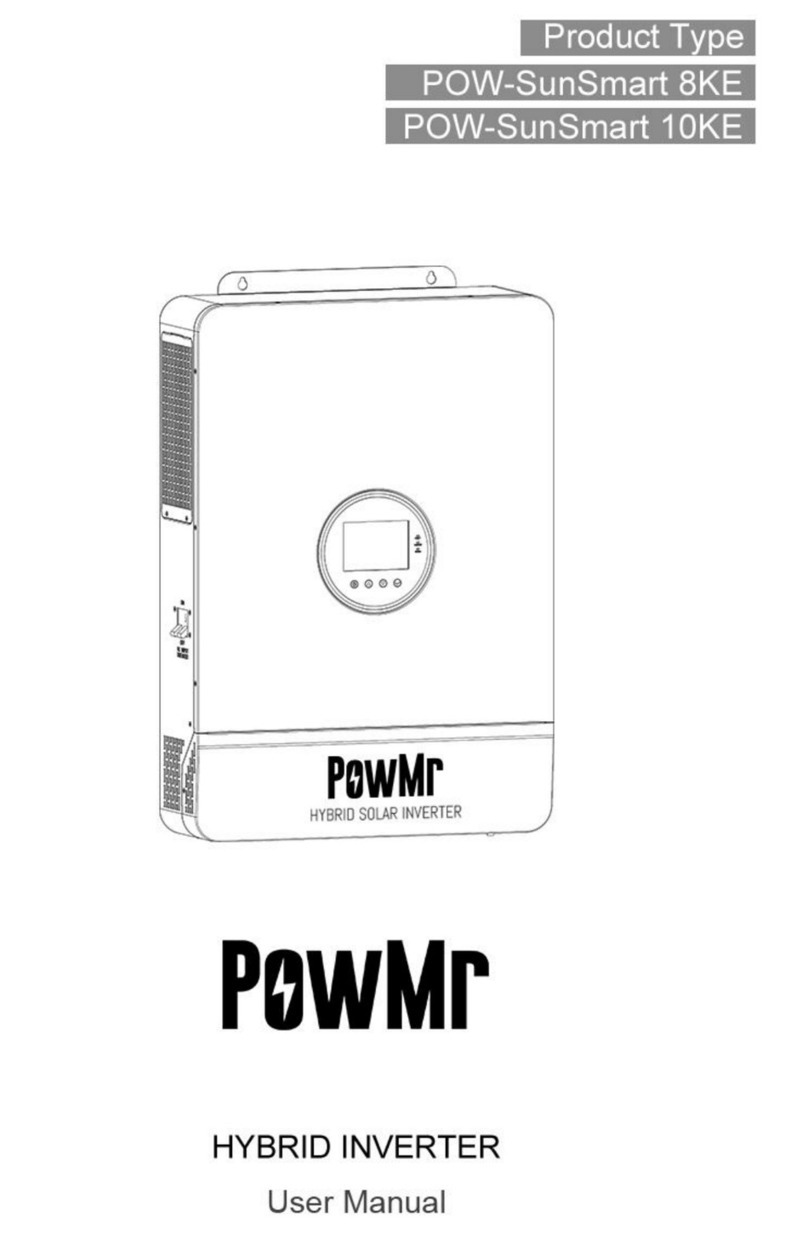
PowMr
PowMr POW-SunSmart 8KE User manual
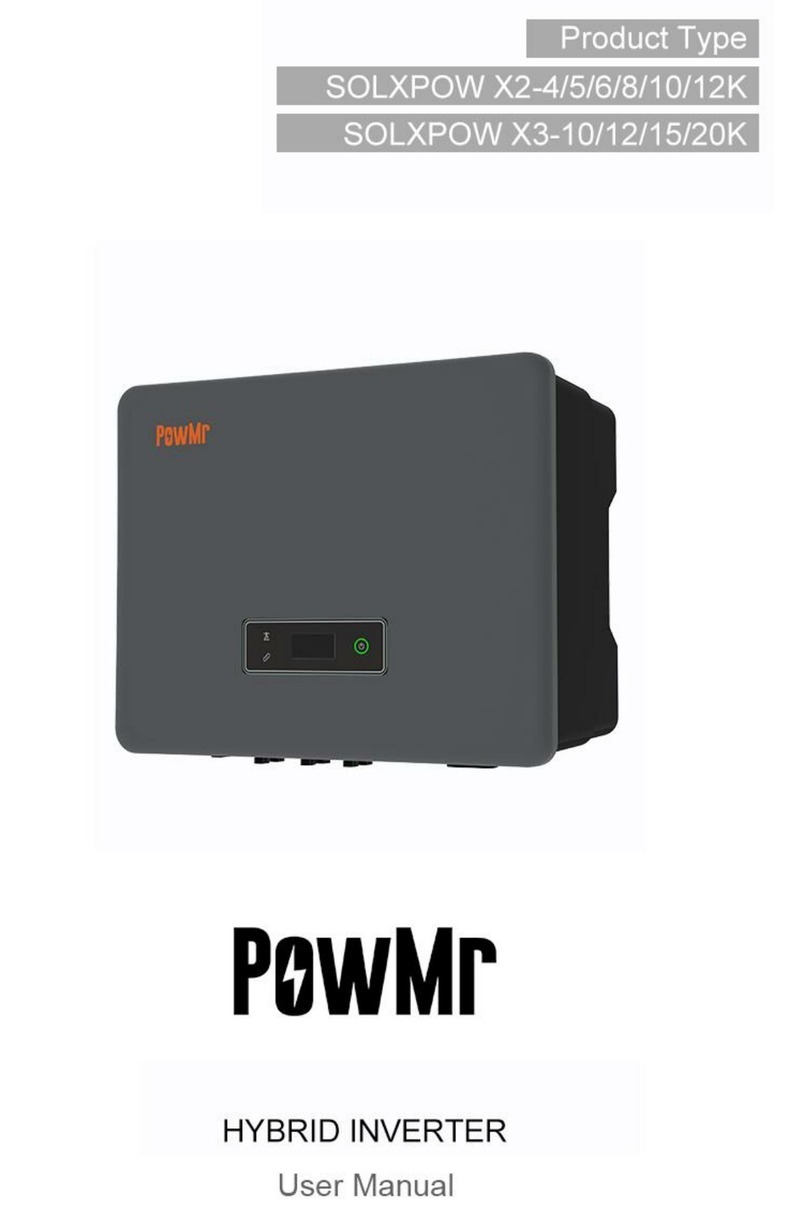
PowMr
PowMr SOLXPOW X2 Series User manual
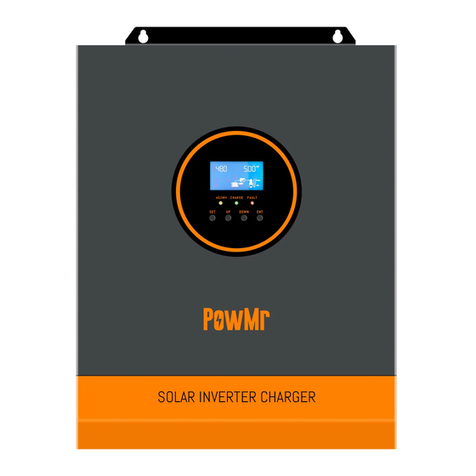
PowMr
PowMr POW-LVM3K-24V-H User manual
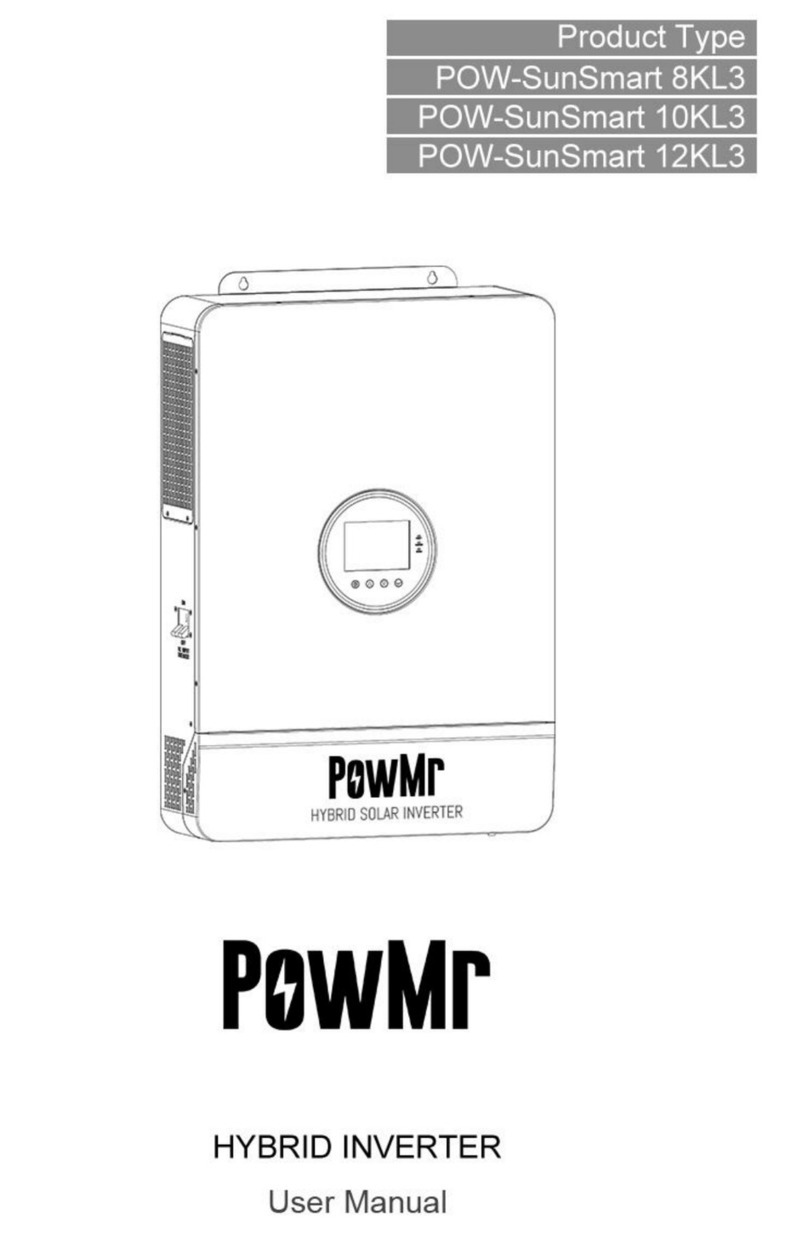
PowMr
PowMr POW-SunSmart 8KL3 User manual

PowMr
PowMr SOLXPOW X1 Series User manual
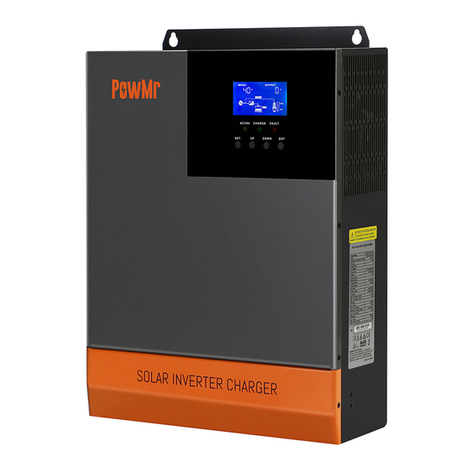
PowMr
PowMr POW-HPM Series User manual
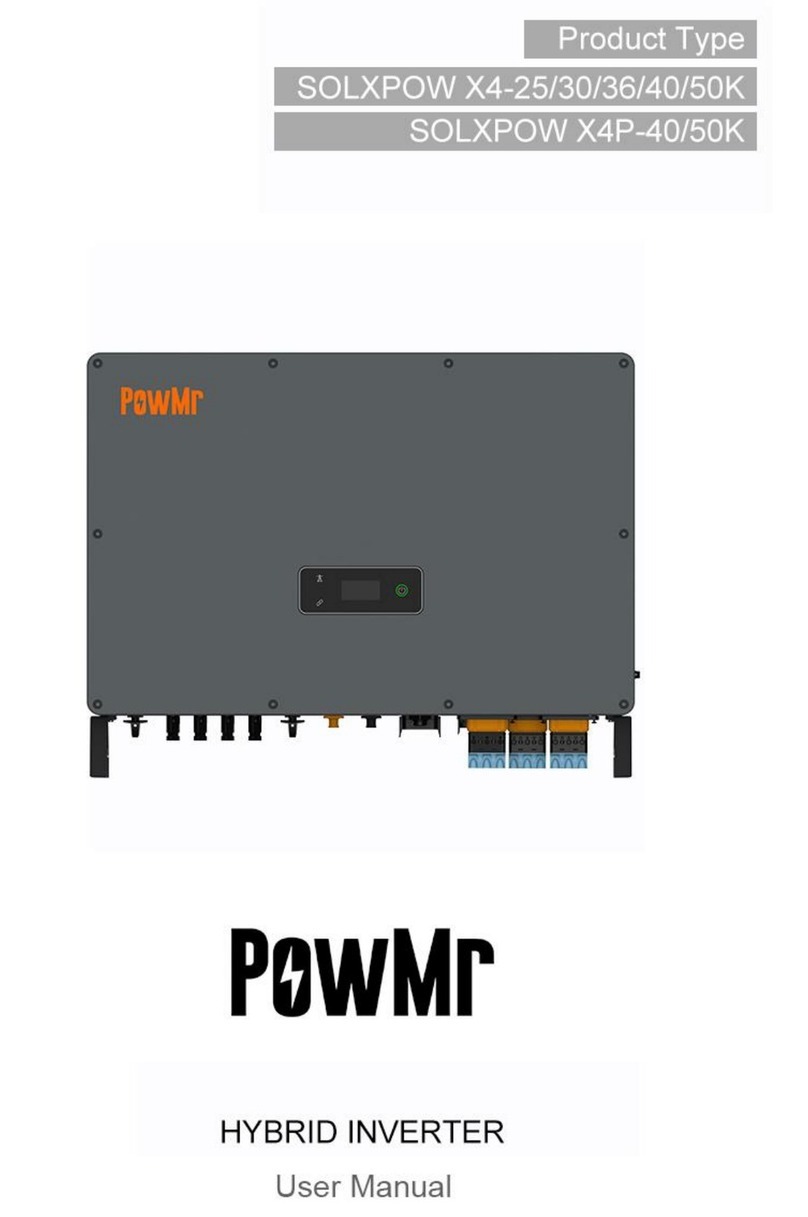
PowMr
PowMr SOLXPOW X4 Series User manual
Popular Inverter manuals by other brands
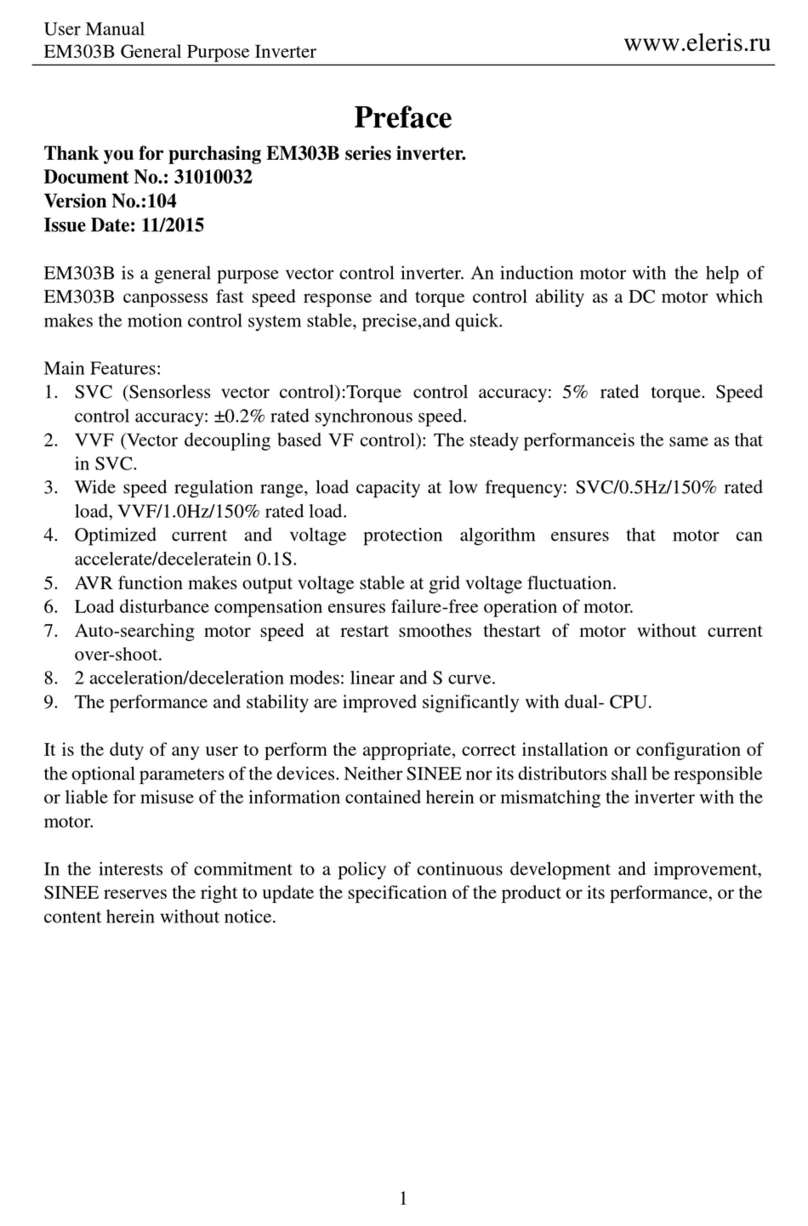
Eleris
Eleris EM303B user manual
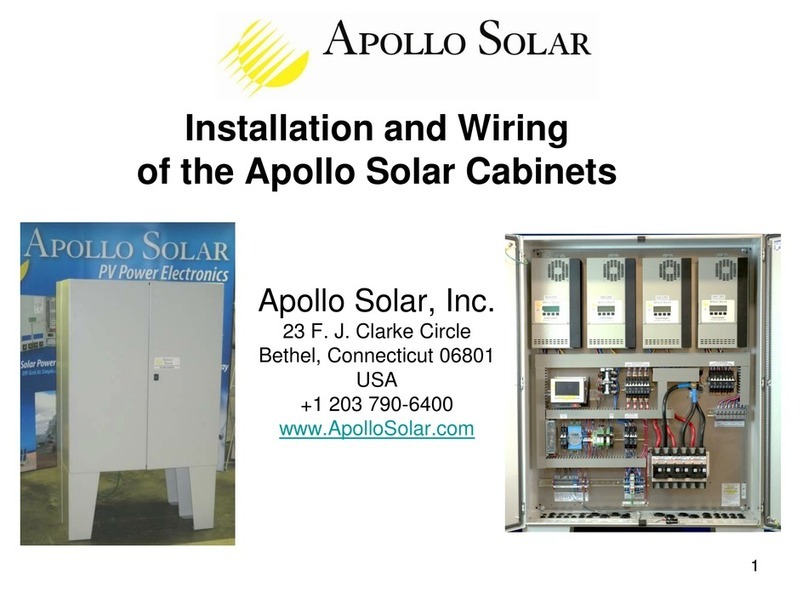
Apollo Solar
Apollo Solar TSW Installation and Wiring
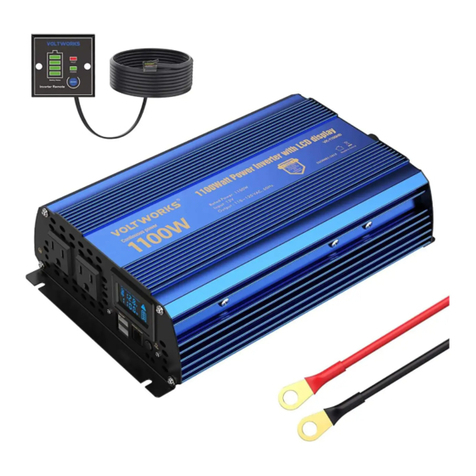
VOLTWORKS
VOLTWORKS VK-1100HB user manual
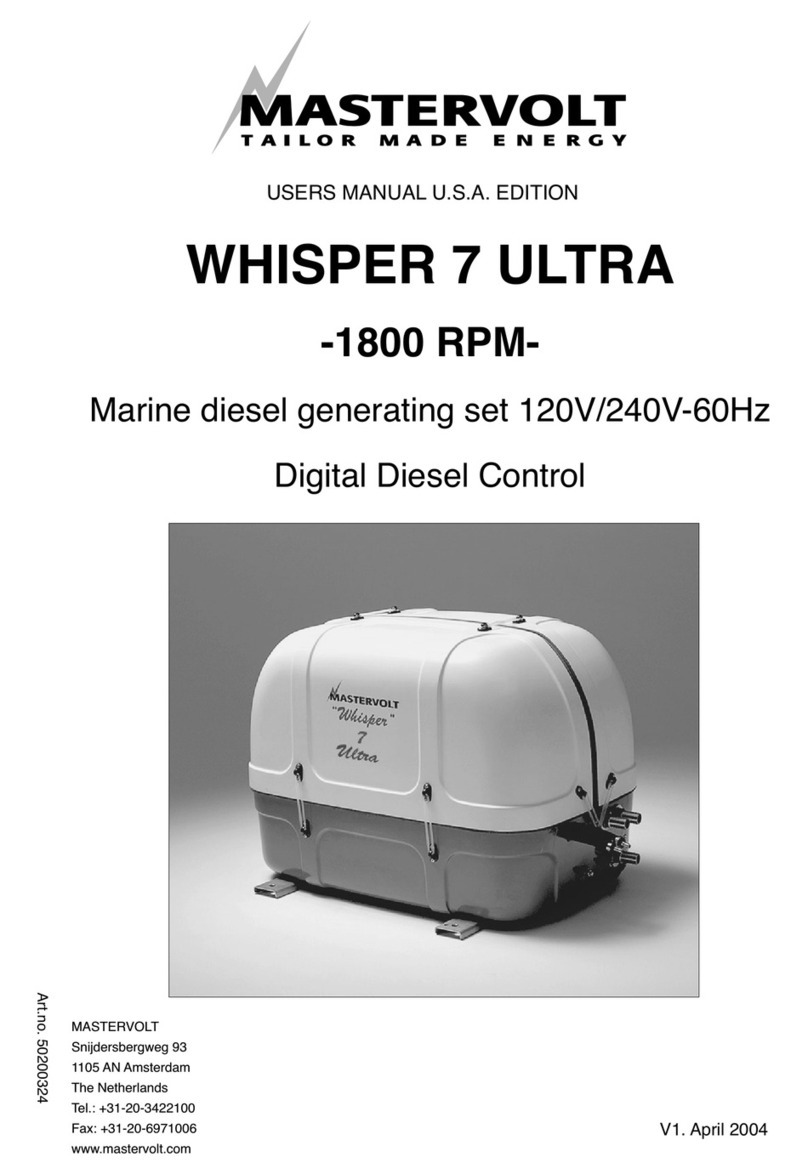
Mastervolt
Mastervolt WHISPER 7 ULTRA user manual

CiTO Power
CiTO Power CPI-500 Series user manual
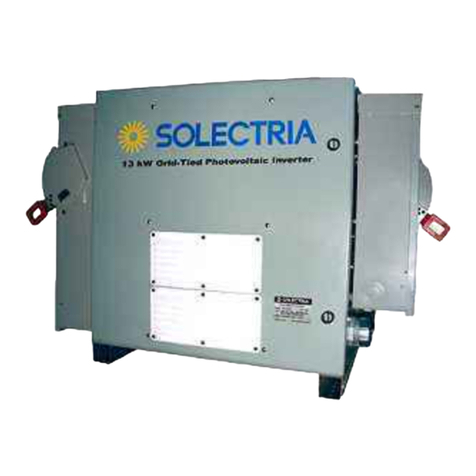
Solectria Renewables
Solectria Renewables PVI 13KW Installation and operation manual
